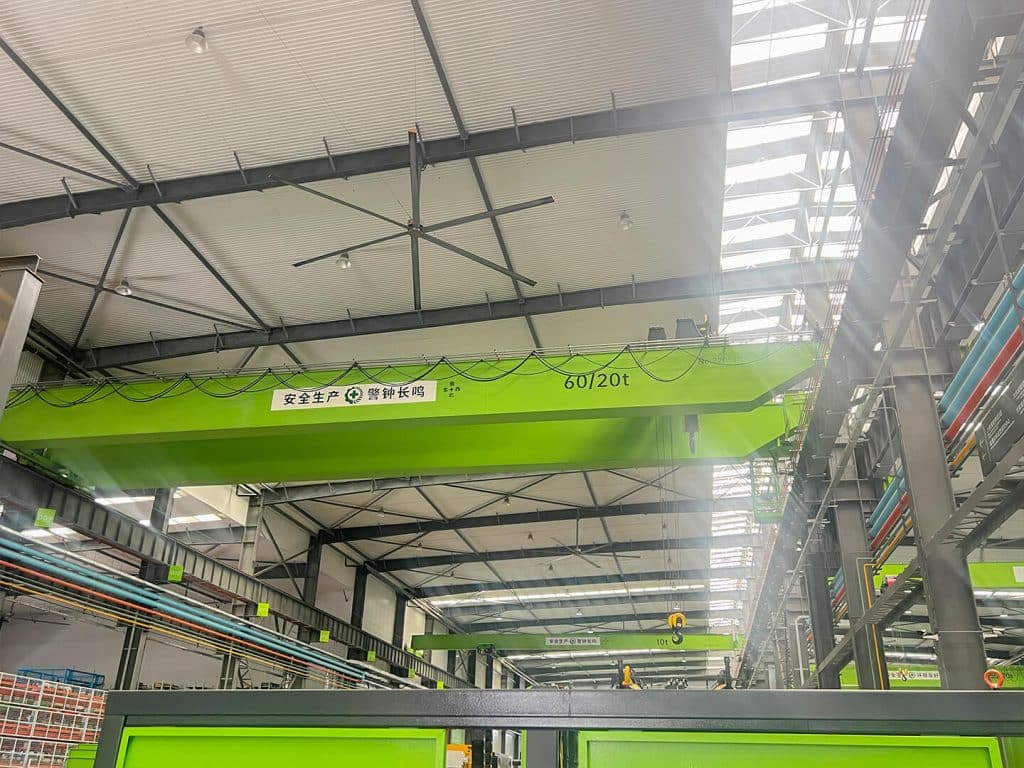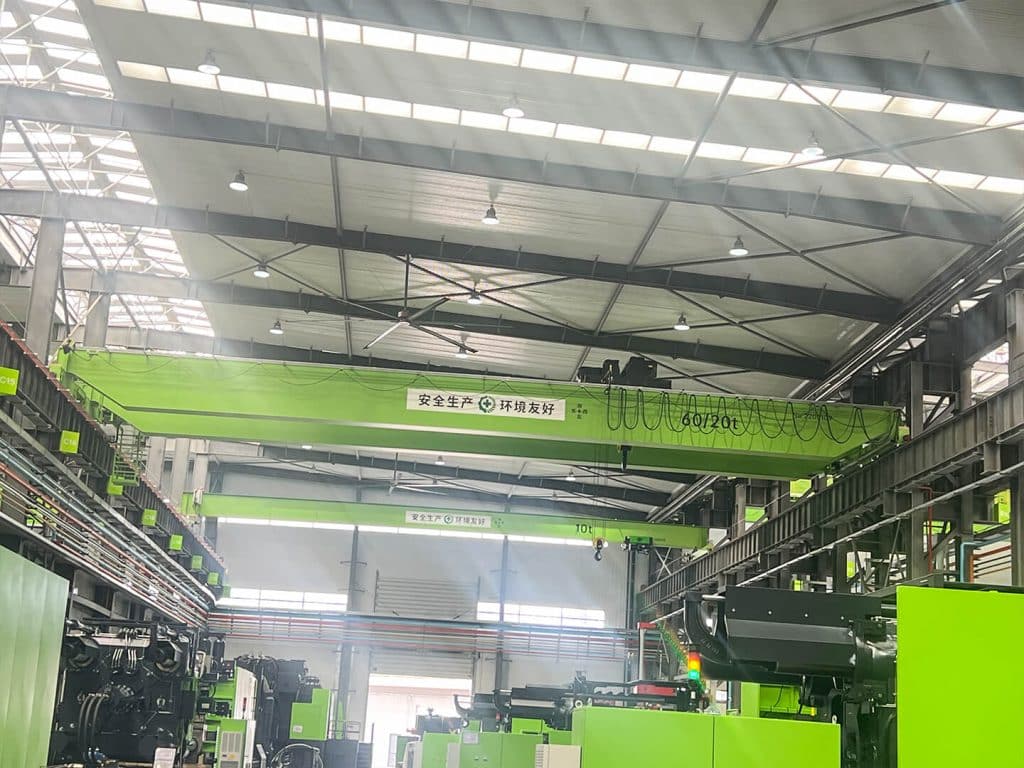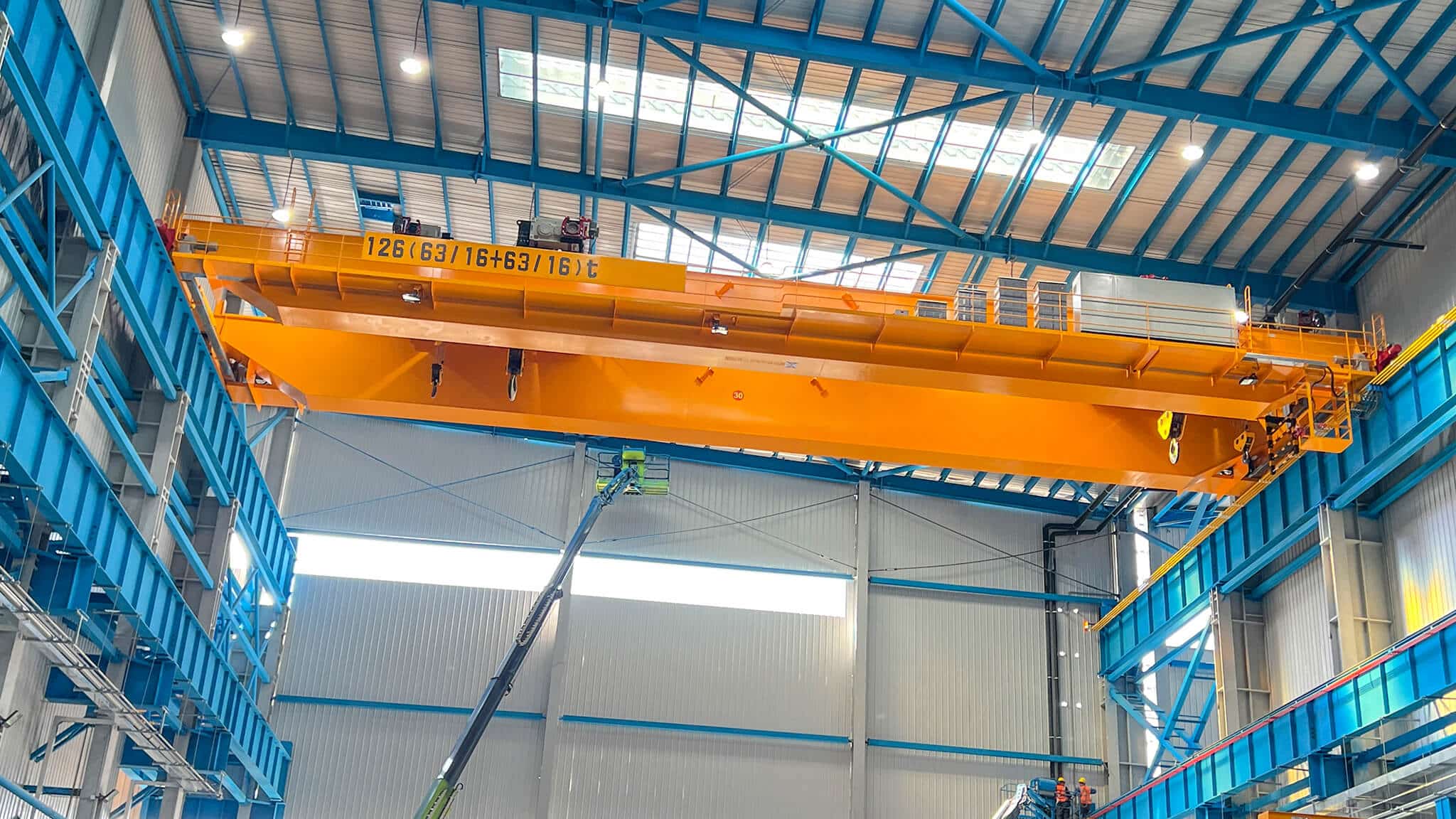
Overhead crane and Their Impact on Injection Molding Efficiency in 2025
Efficiency is key to the success of Injection Molding Machines. However, current methods face challenges that slow down operations. For instance:
Filling time takes between 0.582 and 0.741 seconds.
Cooling time lasts from 4.302 to 7.635 seconds.
Pressure loss in the mold can reach 48.15 MPa.
These challenges require innovative solutions. overhead crane play a significant role in addressing these issues quickly and accurately. By 2025, advancements such as automation, energy-saving systems, and remote controls will revolutionize factories. These innovations will enhance productivity and support eco-friendly initiatives, making them essential for today’s industries.
Understanding Overhead Crane

Key Features and Components
Overhead crane are important tools in today’s factories. They have strong parts and smart designs that improve work. Here are the main parts:
Girders: These are long beams that hold the crane steady and carry heavy loads.
Hoists: These lift and lower heavy items carefully, making work easier.
Trolleys: These move the hoist along the beam, helping to carry things across the area.
End Trucks: These connect the crane to tracks, letting it move smoothly.
These parts make overhead crane useful for many jobs. For example, Guanhui’s Double Girder Overhead Crane can work with different setups like under-running or top-running hoists.
General Applications
Overhead crane are great for moving materials and lifting heavy things. I’ve seen how they help in factories and warehouses. Here’s what they do:
Material Handling in Manufacturing: Smart cranes make work faster by doing tasks like loading and unloading. They reduce the need for workers and speed up production. Sensors help place items exactly where they need to go.
Heavy-Duty Lifting in Industrial Environments: Some cranes, like Guanhui’s Double Girder Overhead Crane, can lift up to 500 tonnes. They save energy and cut costs while being eco-friendly.
More companies are using overhead crane because they work so well. In 2023, they made up 37.3% of global sales. Their advanced features help industries finish tough jobs on time.
Note: New technology like automation and IoT is making cranes faster and more accurate.
Overhead Crane in Injection Molding Machines
Enhancing Operational Efficiency
Overhead crane have changed how molds are moved and set up. They make these tasks faster and more accurate by lifting heavy molds easily. This removes delays caused by lifting molds by hand. For example, Guanhui’s Double Girder Overhead Crane can lift very heavy molds quickly and place them exactly where needed.
Another big benefit is less downtime during repairs. Modern overhead crane have smart systems that predict when repairs are needed. This helps plan fixes before problems happen, keeping work running smoothly.
Here’s a table showing how overhead crane reduce downtime:
Metric | Impact on Downtime |
|---|---|
Predictive Maintenance | Plans repairs to avoid unexpected stops. |
Drastic Reduction in Downtime | Keeps work going by scheduling repair times. |
Overhead crane also move heavy items faster and handle many tasks at once. This improves production speed and avoids delays, making them very useful for injection molding machines.
Improving Safety Standards
Safety is very important, and overhead crane make workplaces safer. They lower risks by reducing the need for workers to lift heavy molds. Guanhui’s cranes have advanced parts like hoists and trolleys that move smoothly, lowering the chance of accidents.
Placing molds correctly is also safer with modern cranes. They use sensors and smart systems to position molds perfectly. This prevents mistakes that could damage equipment or cause safety problems.
Tip:
Pick cranes with smart safety features like automatic load positioning for a safer workplace.
Boosting Productivity
Automation helps get more work done faster. Overhead crane with smart technology handle repeated tasks automatically, saving time and cutting labor costs. For example, in steel factories, these cranes move materials and products with great accuracy.
Here’s how automation improves productivity:
Repeated tasks are done faster with less manual work.
Real-time tracking keeps production running at its best.
Quicker work completion helps meet deadlines on time.
In injection molding machines, this means more products are made with fewer mistakes. Smart systems help handle molds better, increasing production and saving money.
Note:
Using overhead crane has improved material movement and reduced delays, leading to faster production and better results.
By improving efficiency, safety, and productivity, overhead crane are now must-have tools for injection molding machines. Their smart features solve today’s problems and prepare industries for future needs.
Technological Advancements in Overhead Crane

Automation and IoT Integration
Automation and IoT have changed how overhead crane work. Now, systems track load weight and crane positions in real-time. This helps avoid accidents and keeps operations safe. For example, IoT sensors give constant updates about the crane’s performance. Operators can quickly make smart decisions using this data. This has made moving molds in injection molding machines faster and safer.
Automatic load positioning systems are also very helpful. They use special controllers to place loads exactly where needed. Operators can now control cranes remotely, staying away from dangerous areas while working efficiently.
Material Innovations
New materials have made cranes lighter but still strong. High-strength alloys and composites reduce weight while staying durable. This makes cranes easier to install and more energy-efficient. Lighter materials also spread weight better, improving performance.
Modular designs add flexibility to cranes. These designs let cranes fit into tight spaces or different setups. For example, Guanhui’s Double Girder Overhead Crane works well in complex layouts. This makes them perfect for injection molding machines, where saving space is important.
Note: Modular cranes are easy to upgrade, making them a smart choice for growing businesses.
The Future of Injection Molding Efficiency in 2025
Facing Industry Challenges
Faster production and complex molds
Industries want faster production and detailed mold designs. By 2025, new technologies will meet these needs. Automation has already cut production times by 20%. This will improve as more companies use robots and precise tools. These tools make work faster and keep quality high, even with tricky molds.
Efficiency metrics help solve these problems. Here’s how they work:
Efficiency Metric | What It Does |
|---|---|
Mathematical Optimization and DFM | Improves designs with CAD tools, cutting waste and time. |
Automation and Robotics | Uses machines to work accurately and save on labor costs. |
Quality Assurance and ISO Standards | Spots problems early by following strict ISO 9000 rules. |
Eco-Friendly Practices | Helps the planet by using recyclable materials and saving energy. |
These methods help industries make products faster without losing quality.
Reaching sustainability goals
Sustainability is now very important for businesses. Eco-friendly ideas, like recycling and saving energy, are changing how injection molding works. By 2025, these ideas will be common. Companies will use systems that save energy and create less waste with better designs.
The industry is growing because of this change. It’s expected to grow 28% in five years, with a yearly growth rate of 5%. This shows how important sustainable and efficient methods are becoming.
Staying Competitive
Leading in a fast-changing market
To stay ahead, companies must keep improving. Automation and new technology are helping overhead crane do more. Smart cranes now handle materials better and faster. For example, in steel work, these cranes make moving materials easier and more reliable.
Here’s what helps businesses stay on top:
Using automation and new technology.
Working faster and more efficiently.
Following Industry 4.0 ideas for smarter solutions.
These things help companies with advanced cranes lead their industries.
Better products and happier customers
Good quality means happy customers. By 2025, injection molding will improve with automation and quality checks. Systems that watch for mistakes in real-time will reduce errors. This ensures products meet customer needs.
Different industries benefit from these changes. For example:
Sector | Benefits |
|---|---|
Healthcare | Better tools for diagnosing and treating patients. |
Automotive | Safer and better-made vehicles. |
Manufacturing | Faster work and lower costs. |
These upgrades improve quality and build customer trust. Companies using these technologies will succeed and keep customers loyal.
Case Studies: Bridge Crane Success Stories
Real-World Applications
Efficiency improvements in manufacturing plants
Overhead crane have made factories work faster and with fewer delays. Smart cranes with automated systems speed up assembly lines and make them more accurate. For example, in making precision valves, these cranes cut down on mistakes and finished work quicker. This saved time and made customers happier.
Predictive maintenance has also helped a lot. It finds problems early, so cranes keep working without breaking down. This makes them last longer and keeps production moving smoothly. Real-time monitoring systems also help by spotting slow areas and fixing them quickly.
Here are some key benefits:
Precision Assembly with Automated Positioning: Faster work and fewer mistakes.
Predictive Maintenance for Continuous Operation: Less downtime and longer-lasting cranes.
Workflow Optimization through Real-time Monitoring: Better use of resources and higher output.
Quantifiable benefits: cost savings and safety enhancements
The results are clear. One factory had trouble with precise assembly. After using smart overhead crane, they had fewer mistakes and worked faster. Predictive maintenance cut downtime, saving time and money. Real-time monitoring improved how resources were used, boosting productivity.
Case | Problem | Solution | Results |
|---|---|---|---|
Precision Assembly with Automated Positioning | Trouble with precise assembly work | Smart cranes with automated systems | Fewer mistakes and faster assembly times |
Predictive Maintenance for Continuous Operation | Cranes breaking down unexpectedly | Smart cranes with predictive maintenance | Less downtime and longer crane life |
Workflow Optimization through Real-time Monitoring | Slowdowns in work processes | Smart cranes with real-time monitoring | Better resource use and more productivity |
These examples show how overhead crane save money and make workplaces safer. By automating heavy lifting and accurate placement, they lower accident risks and make work easier for operators.
Tip: Pick cranes with predictive maintenance and monitoring to improve safety and efficiency.
Lessons for Implementation
Best practices for adopting bridge crane technology
Using overhead crane needs good planning. First, figure out what your factory needs. Look at your work process and find where cranes can help most. For example, in paper mills, planning crane paths and storage spots has made work faster and smoother.
Here are some tips:
Start with a Needs Assessment: Know what your factory needs.
Choose the Right Crane: Pick one that fits your space and tasks.
Train Your Workforce: Teach workers to use features like automated systems and maintenance tools.
Overcoming common challenges
Adding new technology can be tricky. Some companies find it hard to fit cranes into their current work. But modular designs and flexible options make this easier. For example, Guanhui’s Double Girder Overhead Crane works well in tight spaces and complex setups.
Another issue is training workers. Teaching employees to use advanced systems is very important. Focus on safety and efficiency during training to build confidence and reduce mistakes.
Note: Working with trusted brands like Guanhui gives you custom solutions and ongoing help.
By following these steps, businesses can get the most out of overhead crane, improving operations and achieving long-term success.
Preparing for Advanced Bridge Crane Integration
Business Strategies
Understanding Operational Needs
Before adding advanced overhead crane, it’s important to check what your facility needs. This helps pick a crane that fits your work. For example, knowing the weight and size of items you move daily helps decide the crane’s lifting power. Also, checking your workspace layout ensures the crane fits well without problems.
Looking at market trends can also help. In 2023, the OEM segment led the market with 61.7% of the share. This shows many businesses prefer complete crane systems made for their needs. Here’s a quick look at key market facts:
Aspect | Details |
|---|---|
Market Share | The OEM segment held 61.7% of the market in 2023, showing a preference for custom crane systems. |
Regional Growth | North America had 39.6% of the market in 2023, driven by automation and infrastructure projects. |
Technological Trends | Smart features like remote control and data-based maintenance are becoming popular, improving safety and efficiency. |
Customization | OEMs offer cranes with special features for unique business needs, making them stand out from other types. |
Infrastructure Investments | Big investments in projects across North America and Asia Pacific are increasing demand for strong overhead cranes. |
This data shows how important it is to choose a crane that matches your goals and market trends.
Choosing Trusted Manufacturers Like Guanhui
Picking the right manufacturer is just as important. It’s smart to work with reliable companies like Guanhui. Their Double Girder Overhead Cranes are strong and customizable. These cranes can lift up to 500 tonnes, making them perfect for heavy jobs. Guanhui also offers modular designs, so the crane can fit your facility’s needs.
A good manufacturer makes the process easier. They provide custom solutions, ongoing help, and advanced tools like predictive maintenance and IoT features. This ensures your crane works well for a long time and improves your operations.
Focusing on Safety and Productivity
Safety is always the top priority. Advanced cranes, like Guanhui’s, have features like collision avoidance and real-time tracking. But training is needed to use these tools properly. Emergency drills and regular checks help keep the workplace safe.
Efficiency is also important. Teach workers how to use the crane’s smart features to speed up tasks. For instance, automated systems reduce manual work, making production faster and safer. A trained team improves both safety and productivity.
Tip: Update training often to match new technology and keep safety standards high.
Overhead crane have changed injection molding by making work faster and safer. Their smart features, like automation and predictive maintenance, help avoid delays. Using these technologies is important to keep up in busy industries.
Key Takeaway: Advanced overhead crane, like Guanhui’s Double Girder Overhead Crane, are more than machines—they help businesses grow and succeed.
Try these solutions now to improve your work and build a better future.
FAQ
1. What is a bridge crane?
A bridge crane is a machine that lifts heavy items. It has parts like girders, hoists, and trolleys. These parts work together to move loads in factories. I’ve seen them make work faster and easier in warehouses.
2. How do overhead crane improve safety?
Overhead crane make lifting safer by reducing manual work. Features like collision prevention and accurate load placement lower risks. I suggest picking cranes with smart safety tools for better protection.
3. Can overhead crane handle heavy molds in injection molding?
Yes, overhead crane are great for lifting heavy molds. For example, Guanhui’s Double Girder Overhead Crane can lift up to 500 tonnes. This makes it perfect for injection molding, where heavy lifting is needed.
4. What are the benefits of automation in overhead crane?
Automation helps finish tasks faster and with fewer mistakes. Tools like real-time tracking and automatic load placement save time. I’ve noticed automated cranes also cut costs and improve efficiency.
5. Why is predictive maintenance important for overhead crane?
Predictive maintenance finds problems early to avoid breakdowns. It uses sensors and AI to check the crane’s condition. I’ve seen this method reduce downtime by 30%, keeping work smooth and saving money.
6. How do I choose the right bridge crane for my business?
First, figure out what your business needs. Think about load size, workspace, and tasks. I recommend working with trusted brands like Guanhui for custom solutions that fit your needs.
7. Do workers need special training to operate overhead crane?
Yes, workers need training to use cranes safely. They should learn to use remote controls and safety tools. I’ve seen trained workers handle cranes better, making work safer and faster.
Tip: Update training often to keep up with new technology.


